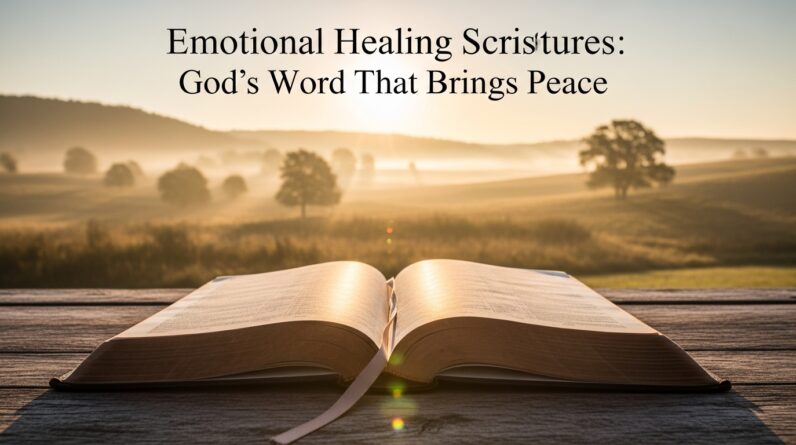From Brokenness To Wholeness: God’s Healing Power In Your Life

You may be carrying pieces of a life that feel shattered: relationships, identity, trust, or hope. You’re not alone in that experience. The Christian story invites you into a reality where God’s restorative power meets your pain, bringing repair and a new sense of wholeness. In this article, you’ll explore what “healing from brokenness” looks like biblically and practically, how God works in the midst of your wounds, and the steps you can take to move toward restoration.
Understanding What Brokenness Feels Like
You know brokenness when it’s in your bones — a loss, betrayal, long-term loneliness, sin’s consequences, or trauma that leaves you numb. It’s not merely sadness; it’s a fragmentation of your inner world and often your outward life. You may feel anxious, mistrustful, ashamed, or stuck.
When you think about healing from brokenness, remember it addresses not only symptoms but the deeper ruptures in your soul. God’s healing touches memories, relationships, meaning, and spiritual identity. Scripture recognizes the depth of human pain and speaks directly into it: “The Lord heals the brokenhearted and binds up their wounds” (Psalm 147:3). That promise does not erase the past; it changes how the past holds you.
What Wholeness Means in a Christian Life
Wholeness isn’t perfection. You won’t become a polished statue with no marks. Instead, wholeness is integration — your heart, mind, body, and spirit functioning in harmony under God’s grace. You become more resilient, more compassionate, and more aligned with the way God designed you to live.
The apostle Paul captures a piece of this when he writes about being a new creation in Christ: “Therefore, if anyone is in Christ, the new creation has come: The old has gone, the new is here!” (2 Corinthians 5:17). Healing from brokenness includes that newness — it’s about being restored into your true identity in Christ.
How God Initiates Healing

God often begins healing in ways you don’t expect. Sometimes it’s a gentle awareness, other times a sudden peace. Jesus modeled compassionate presence and restoration — He touched the outcast, gave sight to the blind, forgave sinners, and comforted the grieving. You can read how He invited the weary to find rest in Him: “Come to me, all you who are weary and burdened, and I will give you rest” (Matthew 11:28).
Healing from brokenness is often relational: God moves through relationships, spiritual practices, and sometimes through professional help. You’re invited to receive, not to perform. God’s sovereignty and your participation coexist — you trust His work while you take concrete steps toward healing.
Scripture That Speaks Directly Into Your Pain
Scripture provides both comfort and direction when you’re working through pain. It doesn’t minimize your struggles; it acknowledges them and offers hope. Here are several passages that speak specifically to healing and restoration.
- Psalm 34:18: “The Lord is close to the brokenhearted and saves those who are crushed in spirit” (Psalm 34:18). You can draw comfort from the nearness of God in your lowest moments.
- Jeremiah 30:17: “But I will restore you to health and heal your wounds,’ declares the Lord” (Jeremiah 30:17). This promise speaks to both physical and emotional restoration.
- Isaiah 61:1–3 (key themes): God’s mission includes binding up the brokenhearted and giving beauty for ashes (Isaiah 61:1-3). Read this passage and let its rhythm reshape your hope.
These passages serve as anchors. Re-reading them, praying through them, and memorizing lines can be part of your recovery process. Scripture speaks into both the reality of your pain and the possibility of transformation.
What Healing from Brokenness Often Looks Like Practically

Healing is seldom an instant switch. It’s a process that tends to follow certain patterns: acknowledgment, lament, acceptance, change, and integration. You can expect cycles — progress with setbacks. That does not mean failure; it means you’re moving through real, human recovery.
- Acknowledgment: You name your wounds and admit what’s true. God meets honesty, not pretense.
- Lament: You allow sorrow to be expressed. The Psalms show you how to pour out grief honestly to God.
- Acceptance and change: You begin to accept what you cannot change and take steps where you can grow, often with the help of others.
- Integration: Your wounds become part of the story that shapes empathy and purpose.
Healing from brokenness includes spiritual practices (prayer, Scripture), relational practices (confession, counseling), and practical choices (boundaries, rest). It’s not one-size-fits-all, but these rhythms repeat in many lives that are being restored.
Prayer, Lament, and Honest Conversation with God
The Bible gives you language for both complaint and trust. Lament is a biblically sanctioned way to bring your pain to God without pretending it’s not real. You can cry, ask hard questions, and still cling to God. As you practice honest prayer, you create space for God to comfort and redirect you.
Jesus taught you to come to God with your needs. Prayer transforms you, not always by removing pain immediately, but by changing your posture toward pain: from isolation and despair to dependence and hope. Let your prayers include both the rawness of your feelings and the small faith-filled petitions that say, “Lord, heal me” — an honest cry aligned with Scripture: “He heals the brokenhearted and binds up their wounds” (Psalm 147:3).
The Role of Community in Your Healing
You weren’t meant to travel alone. Community — whether church, small groups, trusted friends, or a spiritual mentor — is often God’s chosen vehicle for healing. When others see your pain and stay with you, they enact God’s compassion. You need people to pray for you, to speak truth into your situation, and to hold you accountable as you change.
James 5:16 instructs believers to confess sins to one another and pray for each other for healing: “Therefore confess your sins to each other and pray for each other so that you may be healed” (James 5:16). Community doesn’t fix everything, but it is a trustworthy context for transformation.
When Professional Help Is Part of God’s Provision
Healing from brokenness often includes seeking professional help. Counseling, psychotherapy, and medical care are part of the means God uses to restore you. You don’t have to view professional help as a lack of faith. On the contrary, using wisdom and resources can be faithful.
The Bible doesn’t exclude sound, professional help. In fact, the apostle Paul mentions wise counselors and the value of skilled people (consider how the early church organized deacons and elders). If you’ve experienced trauma or depression, a trained counselor or medical professional can offer tools and therapies that integrate with spiritual practices.
Stories That Encourage Hope

You’ll find countless testimonies in Scripture and church history of people who were deeply hurt yet found restoration. Think of David, who experienced betrayal, guilt, and grief, yet wrote psalms that helped a whole people find comfort. Think of Mary Magdalene, presented in the Gospels as a woman delivered from severe affliction, who becomes a witness to resurrection (see Luke’s accounts; read more at Luke 8:2).
Your story may not look exactly like theirs, but the pattern remains: suffering, encounter with Jesus, transformation, and new purpose. Healing from brokenness often converts pain into ministry — your scars can help others who are still hurting.
Practical Steps You Can Take Today
You don’t have to wait to start the work of healing. Here are practical actions that align with spiritual truth and support emotional recovery. You can adapt them to your situation and pace.
- Create a regular rhythm of prayer and Scripture reading. Start small and be consistent.
- Find one trusted person to share your story with and ask them to pray regularly for you.
- Seek a counselor or pastor if you’re dealing with trauma, deep depression, or complex grief.
- Practice small acts of self-care — sleep, balanced food, movement — as part of honoring your body.
- Establish boundaries that protect you from further harm and give space to heal.
- Journal your feelings and track moments of God’s faithfulness and progress.
Each step intentionally shifts you from isolation into healing environments. Healing from brokenness is both spiritual and practical; these steps help you move in both directions.
Dealing with Setbacks and Doubts
You will have days when healing feels impossibly slow or when old wounds flare. That’s normal. The Christian life is not immune to setbacks; it often includes them. What matters is how you respond.
When doubts arise, bring them honestly to God and to a trusted companion. Scripture models this honesty in the Psalms. Remember promises like Romans 8:28 — “in all things God works for the good of those who love him” (Romans 8:28) — while also acknowledging you won’t always see the whole picture. Trust is often a daily choice.
How Forgiveness Intersects with Healing
Forgiveness is often central to healing from brokenness, but it’s not simple or immediate. You may need time and God’s help to forgive those who hurt you, and sometimes forgiveness is a process rather than a single act. Forgiving doesn’t mean forgetting or excusing wrongdoing; it means releasing the desire for personal vengeance and entrusting justice to God.
Jesus directed you to forgive others as a way to live freedom-filled lives. You’re invited to pray for the strength to forgive and to ask for wisdom when reconciliation is not safe or wise. The path toward forgiveness can open doors to deeper healing and peace.
The Role of Hope and Future Orientation
Healing from brokenness is as much about a reoriented future as it is about past repair. God’s promises steer you toward hope. You can picture a future where your wounds inform but do not define you. Scripture points to a God who restores: “He restores my soul” (Psalm 23:3) — a restorative action that reorders your inner life.
Practically, cultivate hope by setting small, achievable goals and celebrating progress. Hope is contagious; it grows as you take faithful steps and see God’s presence in small mercies.
Healing from Trauma: Special Considerations
If your brokenness comes from trauma, the path may require specialized care and longer timelines. Trauma reshapes the nervous system and memory, so healing can involve therapy modalities like EMDR, cognitive-behavioral therapy, or trauma-informed pastoral care. Combining spiritual practices with trauma-informed care can be deeply restorative.
You deserve patient, compassionate care. Reach out for professionals who respect your faith perspective and who can integrate spiritual resources into trauma work. Healing from brokenness that involves trauma often requires teamwork — God, wise counselors, supportive community, and your committed steps.
Spiritual Disciplines That Support Healing
Certain spiritual habits consistently help shape healing over time. These disciplines aren’t magic, but they reorder your inner life toward God’s truth and presence.
- Silence and solitude: Create space to listen to God and sort through emotions.
- Scripture meditation: Dwelling on verses that describe God’s healing and faithfulness recalibrates your mind.
- Worship and gratitude: Even in pain, giving thanks can shift attention from what’s lost to what remains.
- Service: Helping others can redirect grief into meaningful action and reveal new purpose.
As you practice these, you’ll notice an incremental rebuilding of your inner structures. Healing from brokenness often happens in the small, repetitive acts of faithful living.
When to Wait and When to Act
Discernment matters. Some wounds need time to settle; others require immediate action (e.g., escaping abuse). If you’re unsure, seek trusted counsel. Waiting isn’t always passive — it can be an active season of prayer, reflection, and preparation for the next step.
Act where you can: set healthy boundaries, pursue help, and choose life-giving relationships. Wait where wisdom says to gather resources, build resilience, and avoid rushed decisions that might retraumatize you.
How Your Pain Can Become Purpose
One of the most hopeful aspects of healing from brokenness is that your pain can become a platform for compassion and ministry. Many people who walk through deep suffering later use that experience to help others — as counselors, support group leaders, pastors, or simply friends who listen well.
The Bible suggests that God can repurpose our hardest experiences for greater goods. Joseph’s story in Genesis, for example, shows how suffering led to a position that preserved many lives (see Genesis 50:20). While you won’t always see immediate purpose, healing often culminates in a renewed capacity to love and serve.
Misconceptions to Let Go Of
You may carry misconceptions that stall your recovery. Confronting them helps you move forward.
- Misconception: Healing is quick if you have enough faith. Reality: Faith doesn’t guarantee instant relief; it sustains you through the process.
- Misconception: Asking for professional help shows spiritual weakness. Reality: Seeking help is often an act of wisdom and stewardship of the life God gave you.
- Misconception: Forgiveness equals reconciliation. Reality: Forgiveness is inward release; reconciliation is relational and may not be safe or possible.
Reframing these ideas opens room for realistic, compassionate steps forward in your healing journey.
The Long View: God’s Ongoing Work in You
Healing from brokenness is often nonlinear and lifelong. Some wounds heal deeply; others leave scars that remind you where God walked with you. The Christian hope includes not only present restoration but ultimate renewal in Christ’s completed work. You can live with the confidence that God continues to work in you: “And we know that in all things God works for the good of those who love him” (Romans 8:28). That ongoing work invites patience, courage, and daily faith.
Practical Prayer You Can Use
Here’s a short, honest prayer you can speak or adapt. Pray it slowly, letting each line land in your heart.
“Lord Jesus, You see my brokenness. I bring my wounds to You. Heal the places that ache, give me courage for the steps ahead, and surround me with loving people who will walk this path with me. Help me forgive where necessary, seek help where needed, and trust You in the unknown. Restore my soul and make me whole in You. Amen.”
You’ll find that regular, honest prayer is a way of returning to God and reorienting your hope.
A Few Encouraging Promises to Hold On To
When you feel worn, hold these scriptural truths close. They won’t remove hardship instantly, but they will anchor you:
- “The Lord is close to the brokenhearted” (Psalm 34:18).
- “I will restore you to health and heal your wounds” (Jeremiah 30:17).
- “Come to me, all you who are weary and burdened, and I will give you rest” (Matthew 11:28).
Return to these verses often; let them shape your story of healing from brokenness.
Final Reflections: Moving from Brokenness to Wholeness
This journey is not a private achievement; it’s a work of grace. You’re invited to participate with openness, courage, and the conviction that God’s healing is real. As you move forward, expect moments of breakthrough, patience for the slow seasons, and the gentle surprise of new meaning emerging from old pain.
Healing from brokenness is possible because God is a God of restoration. He meets you in your sorrow, walks with you through prayer and people, and invites you into a renewed identity in Christ. Let your hope be steady and your steps brave.

Explore More
For further reading and encouragement, check out these posts:
👉 7 Bible Verses About Faith in Hard Times
👉 Job’s Faith: What We Can Learn From His Trials
👉 How To Trust God When Everything Falls Apart
👉 Why God Allows Suffering – A Biblical Perspective
👉 Faith Over Fear: How To Stand Strong In Uncertain Seasons
👉 How To Encourage Someone Struggling With Their Faith
👉 5 Prayers for Strength When You’re Feeling Weak

📘 Jesus and the Woman Caught in Adultery – Grace and Mercy Over Judgement
A powerful retelling of John 8:1-11. This book brings to life the depth of forgiveness, mercy, and God’s unwavering love.
👉 Check it now on Amazon 🛒💥
🔥 “Every great message deserves a home online.” 🌍💬🏡
Don’t let your calling stay hidden. Start a Christian blog or website using Hostinger — with 99.9% uptime, a free domain, and SSL, your voice can shine for God’s glory anytime, anywhere.
💥 Begin today. 🛒 Try it RISK-FREE! ✅
✝️ “Your body is God’s temple — care for it with purpose.” 💪💖🏛️
Renew your energy and restore balance naturally. Mitolyn helps support a healthy metabolism, giving you the vitality to live out God’s calling with strength and confidence.
🔥 Unlock Your Metabolic Power! ⚡Burn More Calories & Feel Great With Mitolyn. 💪
👉 Start Today. 🚀 Check Price Now. 🛒💰
💰 As a ClickBank & Amazon Affiliate, I earn from qualifying purchases.
📖 Acknowledgment: All Bible verses referenced in this article were accessed via Bible Gateway (or Bible Hub).
🚀 Want to explore more? 👉 Dive into our new post on Why Jesus? and experience the 🔥 life-changing truth of the Gospel!






